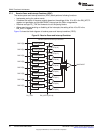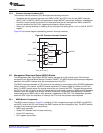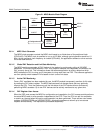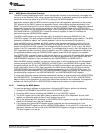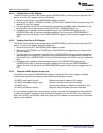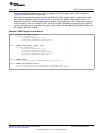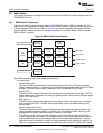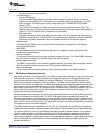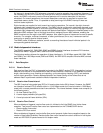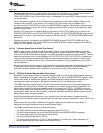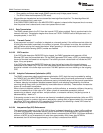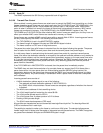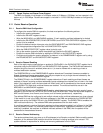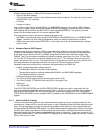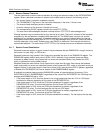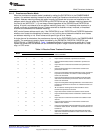
EMAC Functional Architecture
www.ti.com
An interrupt is issued to the CPU whenever a transmit or receive operation has completed. However, it is
not necessary for the CPU to service the interrupt while there are additional resources available. In other
words, the EMAC continues to receive Ethernet packets until its receive descriptor list has been
exhausted. On transmit operations, the transmit descriptors need only be serviced to recover their
associated memory buffer. Thus, it is possible to delay servicing of the EMAC interrupt if there are
real-time tasks to perform.
Eight channels are supplied for both transmit and receive operations. On transmit, the eight channels
represent eight independent transmit queues. The EMAC can be configured to treat these channels as an
equal priority round-robin queue, or as a set of eight fixed-priority queues. On receive, the eight channels
represent eight independent receive queues with packet classification. Packets are classified based on the
destination MAC address. Each of the eight channels is assigned its own MAC address, enabling the
EMAC module to act like eight virtual MAC adapters. Also, specific types of frames can be sent to specific
channels. For example, multicast, broadcast, or other (promiscuous, error, etc.) frames can each be
received on a specific receive channel queue.
The EMAC tracks 36 different statistics, as well as recording the status of each individual packet in its
corresponding packet descriptor.
2.10 Media Independent Interfaces
The EMAC0 supports MII, GMII, RMII, S3MII and RGMII physical interfaces to external PHY devices,
whereas the EMAC1 supports RMII, S3MII and RGMII interfaces.
The following sections discuss the operation of these interfaces in 10/100 Mbps mode (MII, RMII, GMII
and RGMII), and 1000 Mbps mode (GMII and RGMII). An IEEE 802.3 compliant Ethernet MAC controls
these interfaces.
2.10.1 Data Reception
2.10.1.1 Receive Control
Data received from the PHY is interpreted and output to the EMAC receive FIFO. Interpretation involves
detection and removal of the preamble and start-of-frame delimiter, extraction of the address and frame
length, data handling, error checking and reporting, cyclic redundancy checking (CRC), and statistics
control signal generation. Receive address detection and frame filtering of the frames that do not
address-match is performed outside the Media Independent interface.
2.10.1.2 Receive Inter-Frame Interval
The 802.3 required inter-packet gap (IPG) is 24 receive data clocks (96 bit times). However, the EMAC
can tolerate a reduced IPG (2 receive clocks in 10/100 Mbps mode and 5 receive clocks in 1000 Mbps
mode) with a correct preamble and start frame delimiter. This interval between frames must comprise (in
the following order):
1. An Inter-Packet Gap (IPG).
2. A seven bytes preamble (all bytes 55h).
3. A one byte start-of-frame delimiter (5Dh).
2.10.1.3 Receive Flow Control
When enabled and triggered, receive flow control is initiated to limit the EMAC from further frame
reception. Two forms of receive flow control are implemented on the TCI6486/C6472 device:
• Receive buffer flow control
• Receive FIFO flow control
When enabled and triggered, receive buffer flow control prevents further frame reception based on the
number of free buffers available. Receive buffer flow control issues flow control collisions in half-duplex
mode and IEEE 802.3X pause frames for full-duplex mode.
54
C6472/TCI6486 EMAC/MDIO SPRUEF8F–March 2006–Revised November 2010
Submit Documentation Feedback
Copyright © 2006–2010, Texas Instruments Incorporated



